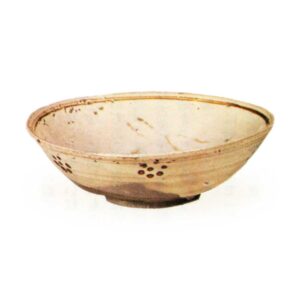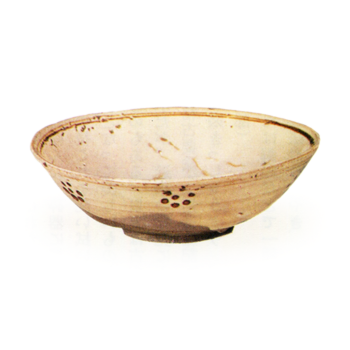
A slightly coarse sugar-white porcelain body with black iron painting. It is found in various regions of China, including the Porizhou kiln. It is not yet known when the name “Egoryeo” originated, but it is clear that it was named by tea masters. After the Japanese invasion of Korea during the Japanese invasion of Korea in 1592, Korean wares became very popular for tea ceremonies, and it is said that wares with black paintings that came from Korea were called Koryo. Some of them are said to have come from Korea, but most of them were miscellaneous daily-use wares from northern kilns in China. There are two types of tea bowls prized in the tea ceremony: plum bowl tea bowls and fish handled tea bowls. The former has a plum bowl design, while the latter has an abbreviated drawing of fish or bamboo grass on the inside of the bowl. The term “E-Goryeo,” as it is called today, is thought to have been given mainly to a type of white porcelain body with black painting fired in Giju. There are various types of E-Goryeo, new and old. Today, black painted white porcelain on white porcelain is famous only in the Porcelain Province of China, but it is not limited to the Porcelain Province of China. Kilns in Dingzhou, and even older, kilns in Xingzhou, Ruzhou, and Zhengzhou, have all been making this type of pottery. The kilns in Boshan, Shandong Province, are said to have been firing this type of ware even in recent years, and the kilns in Benxi Lake, Manchuria, are said to have been firing this type of ware until a few decades ago. In North China, there are always pottery kilns in places where coal is produced, and this type of pottery was fired. The black painted wares include characters, pictures, and patterns, each of which is dated to a different period according to the design of the kiln, but some are difficult to distinguish. There are also many varieties, including jars, bowls, bowls, plates, dishes, tokuri (Japanese tea utensils), containers, dolls, and ceramic pillows. There is a mixture of both refined and vulgar wares, with ancient wares being more elegant and modern wares more vulgar. However, people appreciate them in different ways. Some types of porcelain are dense and hard, but in general the clay is superior, and the unglazed areas after firing absorb moisture and give a rough appearance. The potteries are not fired without first being unglazed, but rather are coated with white clay, painted with patterns in iron-rich red clay, glazed, dried, and then fired with coal in a round kiln in the shape of a helmet, but it is said that wood was used in ancient times. After firing, the glaze, which contains a hint of iron, melts with an ivory color due to oxidative firing, giving the red clay paintings a black or blackish-brown color, and the melted transparent glaze, with its decorative layer, gives a sense of richness, giving the piece a lovely, elegant, and so-called “painted Koryo” appearance in terms of its porcelain quality, glaze, and painting. If the glaze is too well melted, the luster may be too strong, and the black color of the painting may become brown, making it less interesting. The degree of firing depends on one’s taste, but if the black painting is dry in the raw state, it lacks the quality of the ware, and if it is overcooked and the black painting becomes fuzzy, it is detrimental to the eye of the viewer. The above description is based on recent porcelain wares from the Giju kiln, but the term “painted Koryo” also includes wares from other kilns, and is not limited to northern China. The same type of E-Goryeo plum bowls prized by tea masters today were excavated in Gyeongsangbuk-do, Korea. In short, the term “E-Goryeo” was used by tea masters to describe a type of bowl that originally came from Korea, and as long as the appearance was similar, the place of origin did not matter, and the quality was not deeply differentiated. (Taisho Meikikan, Koryo Koso Ceramics, Manzo Nakao)



